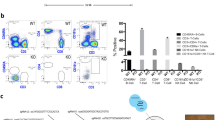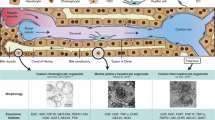Abstract
Mice that could be highly repopulated with human hepatocytes would have many potential uses in drug development and research applications. The best available model of liver humanization, the uroplasminogen-activator transgenic model, has major practical limitations. To provide a broadly useful hepatic xenorepopulation system, we generated severely immunodeficient, fumarylacetoacetate hydrolase (Fah)-deficient mice. After pretreatment with a urokinase-expressing adenovirus, these animals could be highly engrafted (up to 90%) with human hepatocytes from multiple sources, including liver biopsies. Furthermore, human cells could be serially transplanted from primary donors and repopulate the liver for at least four sequential rounds. The expanded cells displayed typical human drug metabolism. This system provides a robust platform to produce high-quality human hepatocytes for tissue culture. It may also be useful for testing the toxicity of drug metabolites and for evaluating pathogens dependent on human liver cells for replication.
This is a preview of subscription content, access via your institution
Access options
Subscribe to this journal
Receive 12 print issues and online access
$209.00 per year
only $17.42 per issue
Buy this article
- Purchase on Springer Link
- Instant access to full article PDF
Prices may be subject to local taxes which are calculated during checkout






Similar content being viewed by others
Change history
11 March 2008
In the HTML version of this article initially published, the statement that the authors had no competing financial interests was incorrect. The authors declare competing financial interests and the details have now been posted online. The error has been corrected in the HTML version of the article.
References
Brandon, E.F., Raap, C.D., Meijerman, I., Beijnen, J.H. & Schellens, J.H. An update on in vitro test methods in human hepatic drug biotransformation research: pros and cons. Toxicol. Appl. Pharmacol. 189, 233–246 (2003).
Gomez-Lechon, M.J., Donato, M.T., Castell, J.V. & Jover, R. Human hepatocytes as a tool for studying toxicity and drug metabolism. Curr. Drug Metab. 4, 292–312 (2003).
Runge, D., Michalopoulos, G.K., Strom, S.C. & Runge, D.M. Recent advances in human hepatocyte culture systems. Biochem. Biophys. Res. Commun. 274, 1–3 (2000).
Cascio, S.M. Novel strategies for immortalization of human hepatocytes. Artif. Organs 25, 529–538 (2001).
Dandri, M. et al. Chronic infection with hepatitis B viruses and antiviral drug evaluation in uPA mice after liver repopulation with tupaia hepatocytes. J. Hepatol. 42, 54–60 (2005).
Sandgren, E.P. et al. Complete hepatic regeneration after somatic deletion of an albumin-plasminogen activator transgene. Cell 66, 245–256 (1991).
Tateno, C. et al. Near completely humanized liver in mice shows human-type metabolic responses to drugs. Am. J. Pathol. 165, 901–912 (2004).
Katoh, M. et al. In vivo drug metabolism model for human cytochrome P450 enzyme using chimeric mice with humanized liver. J. Pharm. Sci. 96, 428–437 (2007).
Turrini, P. et al. Development of humanized mice for the study of hepatitis C virus infection. Transplant. Proc. 38, 1181–1184 (2006).
Grompe, M. et al. Loss of fumarylacetoacetate hydrolase is responsible for the neonatal hepatic dysfunction phenotype of lethal albino mice. Genes Dev. 7, 2298–2307 (1993).
Overturf, K. et al. Hepatocytes corrected by gene therapy are selected in vivo in a murine model of hereditary tyrosinaemia type I. Nat. Genet. 12, 266–273 (1996).
Grompe, M. et al. Pharmacological correction of neonatal lethal hepatic dysfunction in a murine model of hereditary tyrosinaemia type I. Nat. Genet. 10, 453–460 (1995).
Dick, J.E., Bhatia, M., Gan, O., Kapp, U. & Wang, J.C. Assay of human stem cells by repopulation of NOD/SCID mice. Stem Cells 15 Suppl 1, 199–203; discussion 204–197 (1997).
Mombaerts, P. et al. RAG-1-deficient mice have no mature B and T lymphocytes. Cell 68, 869–877 (1992).
Blunt, T. et al. Identification of a nonsense mutation in the carboxyl-terminal region of DNA-dependent protein kinase catalytic subunit in the scid mouse. Proc. Natl. Acad. Sci. USA 93, 10285–10290 (1996).
Traggiai, E. et al. Development of a human adaptive immune system in cord blood cell-transplanted mice. Science 304, 104–107 (2004).
Gorantla, S. et al. Human immunodeficiency virus type 1 pathobiology studied in humanized BALB/c-Rag2−/−gammac−/− mice. J. Virol. 81, 2700–2712 (2007).
Lieber, A., Peeters, M.J., Gown, A., Perkins, J. & Kay, M.A. A modified urokinase plasminogen activator induces liver regeneration without bleeding. Hum. Gene Ther. 6, 1029–1037 (1995).
Lieber, A. et al. Adenovirus-mediated urokinase gene transfer induces liver regeneration and allows for efficient retrovirus transduction of hepatocytes in vivo. Proc. Natl. Acad. Sci. USA 92, 6210–6214 (1995).
Knox, W.E. & Edwards, S.W. Enzymes involved in conversion of tyrosine to acetoacetate. Methods Enzymol. 2, 287–300 (1955).
Meuleman, P. et al. Morphological and biochemical characterization of a human liver in a uPA-SCID mouse chimera. Hepatology 41, 847–856 (2005).
Okamura, K. et al. Generation of hybrid hepatocytes by cell fusion from monkey embryoid body cells in the injured mouse liver. Histochem. Cell Biol. 125, 247–257 (2006).
Aoki, K. et al. Characterization of humanized liver from chimeric mice using coumarin as a human CYP2A6 and mouse CYP2A5 probe. Drug Metab. Pharmacokinet. 21, 277–285 (2006).
Katoh, M. et al. Expression of human cytochromes P450 in chimeric mice with humanized liver. Drug Metab. Dispos. 32, 1402–1410 (2004).
Katoh, M. et al. In vivo induction of human cytochrome P450 enzymes expressed in chimeric mice with humanized liver. Drug Metab. Dispos. 33, 754–763 (2005).
Mercer, D.F. et al. Hepatitis C virus replication in mice with chimeric human livers. Nat. Med. 7, 927–933 (2001).
Nakagawa, S. et al. Hsp90 inhibitors suppress HCV replication in replicon cells and humanized liver mice. Biochem. Biophys. Res. Commun. 353, 882–888 (2007).
Nishimura, M. et al. Evaluation of mRNA expression of human drug-metabolizing enzymes and transporters in chimeric mouse with humanized liver. Xenobiotica 35, 877–890 (2005).
Yoshitsugu, H. et al. Evaluation of human CYP1A2 and CYP3A4 mRNA expression in hepatocytes from chimeric mice with humanized liver. Drug Metab. Pharmacokinet. 21, 465–474 (2006).
Overturf, K., Al-Dhalimy, M., Ou, C.N., Finegold, M. & Grompe, M. Serial transplantation reveals the stem-cell-like regenerative potential of adult mouse hepatocytes. Am. J. Pathol. 151, 1273–1280 (1997).
Wang, X. et al. Cell fusion is the principal source of bone-marrow-derived hepatocytes. Nature 422, 897–901 (2003).
Kostrubsky, V.E. et al. The role of conjugation in hepatotoxicity of troglitazone in human and porcine hepatocyte cultures. Drug Metab. Dispos. 28, 1192–1197 (2000).
Kostrubsky, S.E. et al. Inhibition of hepatobiliary transport as a predictive method for clinical hepatotoxicity of nefazodone. Toxicol. Sci. 90, 451–459 (2006).
Schiedner, G. et al. Selective depletion or blockade of Kupffer cells leads to enhanced and prolonged hepatic transgene expression using high-capacity adenoviral vectors. Mol. Ther. 7, 35–43 (2003).
McKenzie, J.L., Gan, O.I., Doedens, M. & Dick, J.E. Human short-term repopulating stem cells are efficiently detected following intrafemoral transplantation into NOD/SCID recipients depleted of CD122+ cells. Blood 106, 1259–1261 (2005).
Yamamoto, N. et al. An optimal culture condition maintains human hepatocyte phenotype after long-term culture. Hepatol. Res. 35, 169–177 (2006).
Strom, S.C. et al. Use of human hepatocytes to study P450 gene induction. Methods Enzymol. 272, 388–401 (1996).
Komoroski, B.J. et al. Induction and inhibition of cytochromes P450 by the St. John's wort constituent hyperforin in human hepatocyte cultures. Drug Metab. Dispos. 32, 512–518 (2004).
Wang, X. et al. Kinetics of liver repopulation after bone marrow transplantation. Am. J. Pathol. 161, 565–574 (2002).
Kostrubsky, V.E. et al. The use of human hepatocyte cultures to study the induction of cytochrome P-450. Drug Metab. Dispos. 27, 887–894 (1999).
Wen, Y.H. et al. Effects of bergamottin on human and monkey drug-metabolizing enzymes in primary cultured hepatocytes. Drug Metab. Dispos. 30, 977–984 (2002).
Berry, M.N. & Friend, D.S. High-yield preparation of isolated rat liver parenchymal cells: a biochemical and fine structural study. J. Cell Biol. 43, 506–520 (1969).
Acknowledgements
This work was supported by NIH grant RO1-DK48252 and funds from the Juvenile Diabetes Foundation to M.G. and NIH grants DK 92310 and GM 06346 to S.S.
Author information
Authors and Affiliations
Contributions
H.A., primary experimenter, performed all transplantations and analyzed repopulated mice; N.P., FISH in Supplementary Figure 2; A.R., E.E., drug metabolism and drug metabolism gene expression; C.D., FACS analysis; M.A.-D., mouse breeding and transplantation assistance; S.S., provided human hepatocytes and supervised drug metabolism work; M.A.K., provided urokinase adenovirus; M.F., all tissue histology; M.G., overall project planning and coordination.
Corresponding author
Ethics declarations
Competing interests
M.G. owns stock shares in Yecuris, Inc., which has licensed the FRG liver repopulation technology.
Supplementary information
Supplementary Text and Figures
Supplementary Figures 1 and 2 (PDF 1068 kb)
Rights and permissions
About this article
Cite this article
Azuma, H., Paulk, N., Ranade, A. et al. Robust expansion of human hepatocytes in Fah−/−/Rag2−/−/Il2rg−/− mice. Nat Biotechnol 25, 903–910 (2007). https://doi.org/10.1038/nbt1326
Received:
Accepted:
Published:
Issue Date:
DOI: https://doi.org/10.1038/nbt1326
This article is cited by
-
From NAFLD to MASLD: implications of the new nomenclature for preclinical and clinical research
Nature Metabolism (2024)
-
Cell therapy in end-stage liver disease: replace and remodel
Stem Cell Research & Therapy (2023)
-
An overview of mouse models of hepatocellular carcinoma
Infectious Agents and Cancer (2023)
-
A human iPSC-derived hepatocyte screen identifies compounds that inhibit production of Apolipoprotein B
Communications Biology (2023)
-
Behavioral and cognitive performance of humanized APOEε3/ε3 liver mice in relation to plasma apolipoprotein E levels
Scientific Reports (2023)



